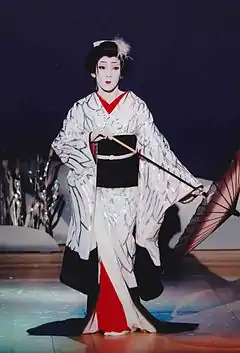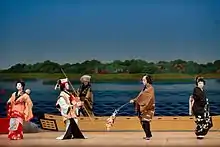Buyō
Buyō (舞踊), or Nichibu (日舞) short for Nihon buyō/Nippon buyō (日本舞踊) meaning Japanese dance,[1] refers to a classical Japanese performing art that may be a dance sometimes mixed with pantomime. It begins with early dance traditions such as mai and odori, with major development in the early Edo period (early 17th century) in the form of kabuki dances, which incorporated elements from the older dance genres.[2][3] Although the term Nihon buyō means "Japanese dance", it is not meant to refer to Japanese dance in general, rather it refers to a few dance genres such as kabuki buyō performed in theatre, Kamigata mai that encompasses the style of dancing performed by geisha, as well as some Japanese dances with modern choreography.[4][5] Nihon buyō differs from other Japanese traditional dances in that it is a more refined style of dancing intended as entertainment on a public stage.[1][4]

The term buyō is a modern coinage during the Meiji period as a term for "dance", and the writer Tsubouchi Shōyō is believed to be the first to use the term Nihon buyō.[6] Prior to this, dance was generally referred according to its particular dance genre, such as mai and odori. The term is a combination of mai (舞, which can also be pronounced bu) and odori (踊, can also be pronounced yō).[7] Shōyō intended Nihon buyō to be a term for Furigoto Geki (振事劇), a form of dance drama in Kabuki plays, but it has now become a term that covers several Japanese dance styles, including the modern dance form Sosaku Buyō.[4] As a genre of dance that has multiple influences and borrowings from many different dance traditions that developed over a long period, one that overlaps with theatre and has many different schools, there is some difficulty in defining and categorizing Nihon buyō.[8]
Influences and components

Nihon buyō is a broad genre of dances that have been refined and improved over four centuries.[1] It has roots in kabuki as well as furyu (風流, popular dances).[9] There are three main elements to Nihon buyō – mai, odori, and furi. Mai is a refined, reserved, and expressive style of dance with few jumps or quick movements; odori is a more energetic dance style, with leaps and lively movements; and furi is the gestures and pantomime movements from kabuki dance.[6]
There are a number of influences that are the building blocks of Nihon buyō, the most significant of these being kabuki buyō.[1]
Kabuki
Dances in kabuki theatres are based on earlier dance traditions, and have the three principal aspects of mai, odori, and furi, as well as incorporating michiyuki borrowed from bunraku dance scenes. Kabuki buyō was started in the early 17th century by Izumo no Okuni who formed a female dance troupe in Kyoto. It grew within the framework of the kabuki theatre and became fully developed in the late 17th through mid 18th century performed by onnagata.[2]
Noh
The second part of Nihon buyō is noh.[1] Nihon buyō takes a few key elements from noh such as the circular movements and the tools used in its dances.
Folk dances
The third component comes from elements of folk dances. Folk dances are among the earliest of dances in Japan, and they form the basis of many later dance genres. The spinning and jumping movements used in folk dances have become incorporated into Nihon buyō.

Shin Buyō
The last part arose out of influences from European and American culture introduced in the modern era in Japan.[1] The writer Tsubouchi Shōyō, the originator of the term Nihon buyō,[6] proposed changes to kabuki theatre under the influence of Western art forms. These ideas were adopted by some kabuki actors, and also led to the development of a new dance form termed shin buyō.
Shin buyō (新舞踊, new dance) began in the early 20th century during the Taishō period when kabuki dancer-actors began to experiment with new approaches to kabuki theatre.[10] Dances on traditional and classical themes may be performed with new choreography, and contemporary popular music may be used to accompany the dance. In the mid 20th century performers, choreographers, non-kabuki dance masters including geishas created experimental shin buyō dance groups.[2]
Categories
.jpg.webp)

Nihon buyō may also be grouped into four main categories: kabuki buyō, su odori, kamigata mai, and sōsaku buyō.[9]
- Kabuki buyō (歌舞伎舞踊) – Kabuki buyō is performed in typical kabuki setting, costume and design. A notable example of Kabuki buyō is The Dancing Girl at the Dojoji Temple (京鹿子娘道成寺, Kyoganoko Musume Dojoji), a performance in which the dancer performs for nearly an hour.[11][12][13] A buyō performance outside of a kabuki play may be taken unchanged from the play, or with some modifications to the choreography, for example changing a duet to a solo.[14] One difference of Nihon buyo from traditional kabuki is that kabuki is performed by men including the female roles, while Nihon buyo is often performed by women. Traditional kabuki also often contains spoken elements, but performers in Nihon buyo rarely speak.
- Su odori (素踊り) or goshugimono (御祝儀物) – this is a stripped down version of a dance that is related to Kabuki buyō. It is performed in a formal kimono but not the more elaborate costume of kabuki or other dance costuming. It is usually performed without dance staging, with the dancer often using only a fan.[15] The fan is the most important prop in Nihon buyō, and can be used to represent various other objects in the dance such as falling cherry blossom petals, leaves in the wind, waves, or a sake bottle or cup, and as a means of conveying emotion or atmosphere.[16]
- Kamigata mai (上方舞) – Named after the Kamigata region of Kyoto and Osaka, this include pieces performed by geishas. The dance developed in the Tokugawa period as a dance for private parties or dinners of patrons, and may be performed in spaces as small as one tatami mat. It is most often performed by women and its movements are typically slow and gentle.[4][17] It may be accompanied by music called jiuta performed by a single shamisen player, in which case it may be called jiuta mai, or it may be called zashiki mai 座敷舞 after the room it is performed in. Nowadays, the dance may also be performed in a theatre, and very occasionally presented as a large-scale spectacle such as the Miyako Odori in Gion, Kyoto first shown in 1872.[18]
- Sōsaku buyō (創作舞踊) – it means "original buyō", and includes dances with modern choreography.[9]
Schools
There are numerous schools or ryū of Nihon buyō, each one headed by a sōke or headmaster.[19] There are believed to be more than 200 schools, but only five of these are considered major schools:[20]
References
- "What is nihon buyo?". Archived from the original on 2006-07-07. Retrieved 2006-05-06.CS1 maint: bot: original URL status unknown (link)
- Samuel L. Leiter (1 October 2014). Historical Dictionary of Japanese Traditional Theatre (2nd ed.). Rowman & Littlefield. pp. 55–57. ISBN 978-1442239104.
- "What is Nihon Buyo?". Nihon Buyo Foundation. Archived from the original on 25 April 2006.
- Takashi Izuha, Keiichiro Uetsuki & Mieko Marumo. "Shoyo's Nihon Buyo" (PDF). Society of Dance History Scholars Proceedings: 94–97.CS1 maint: uses authors parameter (link)
- Global perspectives on dance pedagogy. 2009. p. 228.
- Tomie Hahn (7 May 2007). Sensational Knowledge: Embodying Culture Through Japanese Dance. Wesleyan University Press. pp. 27–28. ISBN 978-0819568359.
- Oshima, Mark (29 June 2009). Sandra Buckley (ed.). The Encyclopedia of Contemporary Japanese Culture. Routledge. p. 75. ISBN 978-0415481526.
- Hahn, Tomie (2007-05-07). Sensational Knowledge. Wesleyan University Press. pp. 24–31. ISBN 9780819568359.
- Hahn, Tomie (2007-05-07). Sensational Knowledge. Wesleyan University Press. p. 24. ISBN 9780819568359.
- Samuel L. Leiter (2013-04-17). Kabuki at the Crossroads: Years of Crisis, 1952-1965. Martinus Nijhoff Publishers / Brill Academic Publication. p. 55. ISBN 9789004251144.
- "Kyoganoko Musume Dojo-ji (The Dancing Girl at the Dojoji Temple)". Kabuki on the Web. Archived from the original on 20 December 2016.
- "Kyoganoko Musume Dojoji". Japan Arts Council. Archived from the original on 2018-05-29. Retrieved 2018-05-27.
- "The Maiden at Dojoji Temple". Kabuki Play Guide.
- Rutherford Malm, Joyce (1977). "The Legacy to Nihon Buyō". Dance Research Journal. 9 (2 (Spring - Summer, 1977)): 12–24. doi:10.2307/1478063. JSTOR 1478063.
- "Su-odori 素踊り". Japanese Performing Arts Resource Centre.
- Terman, Jennie (17 September 2015). "A Beginner's Guide to Japanese Classical Dance". National Endowment for the Arts.
- Raju Thakrar. "Kyoto style comes to Edo". The Japan Times.
- Jonah Salz, ed. (14 July 2016). A History of Japanese Theatre. Cambridge University Press. ISBN 9781107034242.
- Klens, Deborah S. (1994). "Nihon Buyō in the Kabuki Training Program at Japan's National Theatre". Asian Theatre Journal. 11 (2): 231–241. doi:10.2307/1124230. JSTOR 124230.
- "About Ryu-ha". Reitoku Kai.
- "About Hanayagi-Ryu". Reitoku Kai.
- "The Art of Nihon Buyo". Asij News. 19 October 2015.
- "Brief History of the Soke Fujima-ryu". Soke Fujima-ryu lchiFuji-kai Dance Association.
- "WAKAYAGI, Kayono". The Japan Society.
- "Nihon Buyo – Intrinsic Elegance of Classical Japanese Dance". The Japan Society.
- "Thank you very much for visiting the Bando-Ryu home page". Bando-ryu.
External links
- Nihon Buyo Association The main organisation for Nihon Buyo
- Nihon Buyo delights UK Audiences - May 16, 2005 Archived July 26, 2006, at the Wayback Machine
- Tachibana School of Nihon Buyo*
- "Kyoto Buyo". Archived from the original on 2009-10-17. Retrieved 2009-03-28.